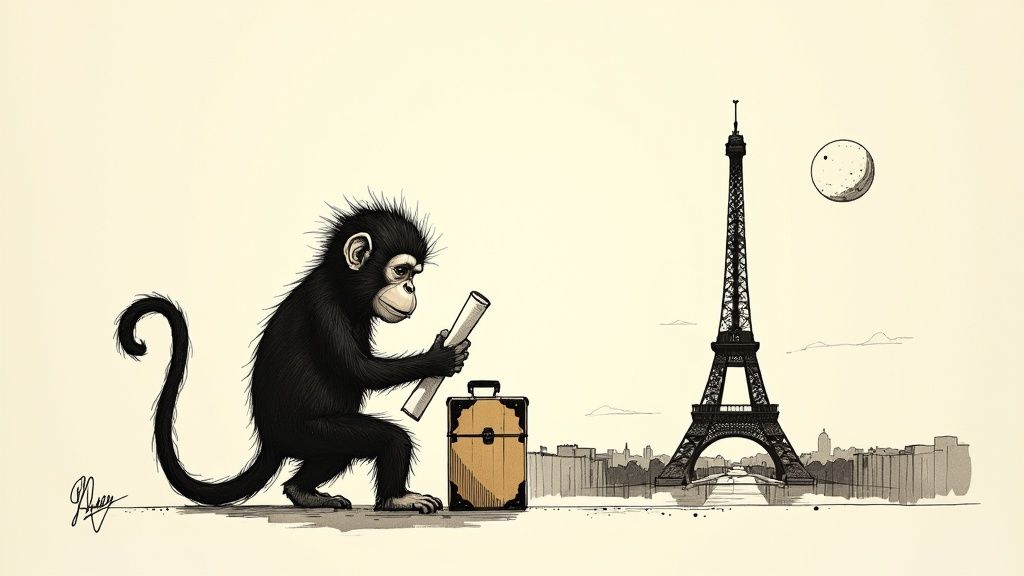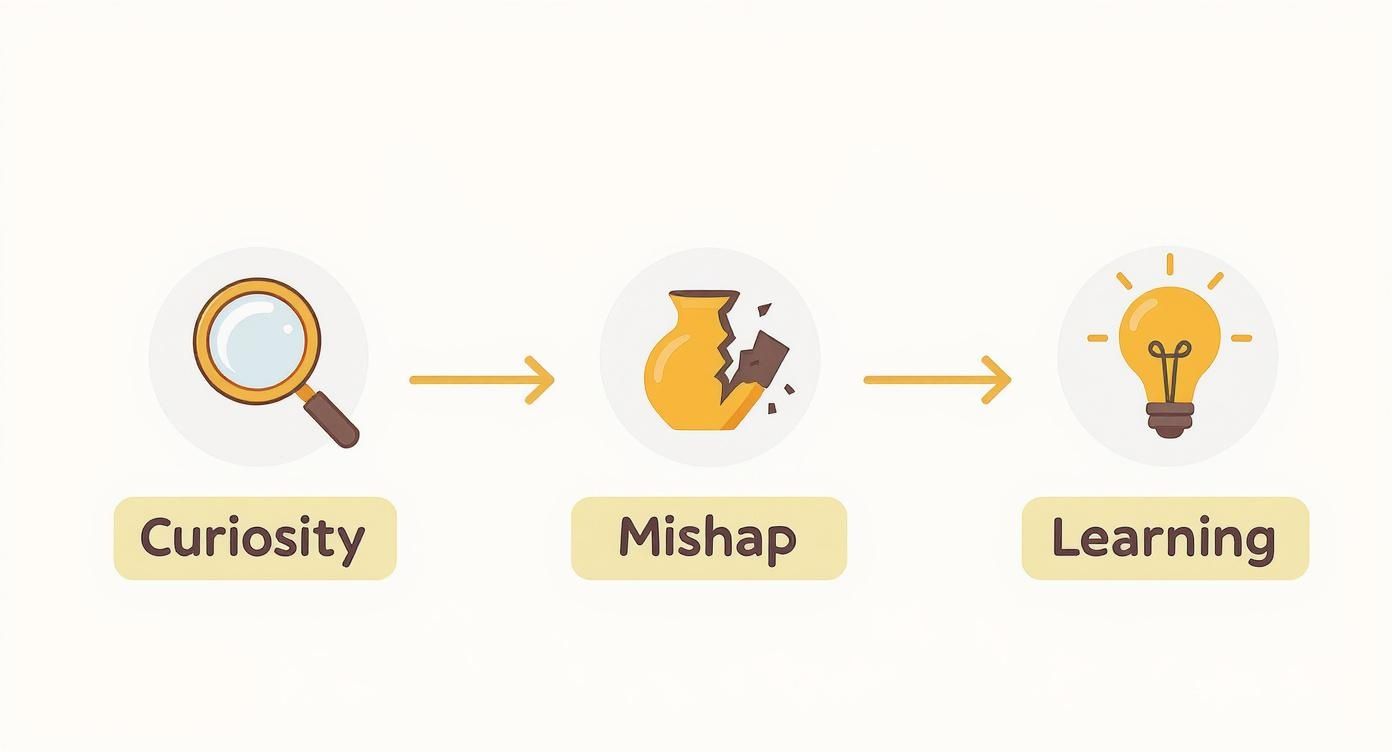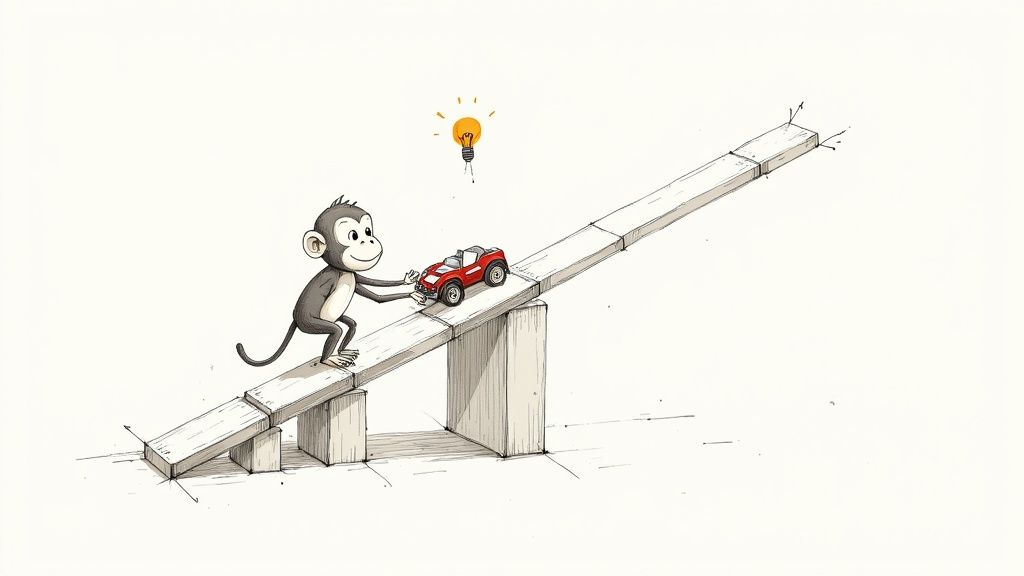The story behind Curious George is so much more than a simple children's tale—it's a narrative of survival, incredible resilience, and what turned out to be perfect timing. The beloved character we all know and love didn't begin his journey with a playful adventure, but with a heart-pounding escape from Paris in 1940. That little monkey was born from the sheer determination of his creators, Margret and H.A. Rey.
The Remarkable Origin of Curious George
The true story of Curious George is just as thrilling as any of his fictional escapades. His creators, Margret and H.A. Rey, were German Jews living in Paris when they found themselves in a truly perilous situation. As Nazi forces closed in on the city in June 1940, they had to make a quick decision that would save not just their lives, but also the manuscript for a very curious little monkey.
With almost no time to spare, they fled the city on makeshift bicycles. They carried only what was absolutely essential, and thankfully, that included the watercolor illustrations and the story that would eventually become Curious George. Their harrowing journey took them across France, into Spain and Portugal, before they finally found safety in New York City. Their escape is a powerful testament to their courage and the deep belief they had in the story they carried with them.
From Humble Beginnings to Lasting Fame
Once they arrived in America, the Reys landed a publishing deal, but the book’s path to becoming a classic was far from guaranteed. The first edition, published by Houghton Mifflin in August 1941, had a modest print run of just 7,500 copies. Titled simply Curious George, it sold for $2.00 but really struggled to connect with an audience. You can learn more about the book's publishing history on Wikipedia).
This screenshot shows the cover of that very first edition, a real piece of history from the book's humble start.

The simple, classic art style you see here is what would, decades later, capture the hearts of millions of children and parents.
In fact, the book faced some serious commercial headwinds. Just five years after its debut, the publisher was actually thinking about stopping the print run entirely because sales were so slow. It looked like the little monkey’s adventures might be over before they ever truly got started.
But persistence paid off. Over the next few decades, word-of-mouth and a growing appreciation for its gentle storytelling allowed the book’s popularity to slowly and steadily build.
This gradual success is a powerful lesson in itself. The original Curious George book, once on the brink of being discontinued, has now sold over 25 million copies worldwide. The spirit of resilience that got the Reys out of Paris seems to be woven right into the fabric of their creation’s legacy. It’s a story that reminds us that even the most celebrated classics can come from the most precarious of beginnings.
Why Curiosity Is George's Superpower
The secret to every Curious George story isn't just mischief; it's the powerful engine of discovery packed into his very name. George’s defining trait has always been an insatiable curiosity that pulls him to explore, touch, and figure out everything around him. This perfectly mirrors the way a young child learns—every object is a question, and every action is a tiny experiment.
When he spots a kite, he has to know how it flies. When he finds a box of donuts, he can't help but wonder what happens if you stack them all up. This is exactly how kids learn, by getting their hands dirty and interacting directly with the world. George’s adventures are really just a big, fun analogy for this process, showing us that real understanding comes from doing, not just watching from the sidelines.
Learning Through Comical Mishaps
Of course, George's explorations almost always spiral into some kind of hilarious chaos. He might flood an entire apartment trying to sail a toy boat or accidentally call the fire department while playing with the phone. But these messes aren't failures; they're just the natural result of genuine inquiry.
This predictable cycle is where the real educational magic happens. It teaches children a crucial lesson about resilience and the simple fact that it's okay to make mistakes. The stories never frame these blunders as bad behavior, but as learning opportunities. George doesn't get punished for his curiosity; he just learns the natural consequences of his actions.
For example:
- The Kite Adventure: George grabs a bunch of balloons to chase a runaway kite, getting a very hands-on lesson about how wind and buoyancy work.
- The Donut Disaster: While working at a donut shop, his trial-and-error approach to stacking donuts creates a huge mess but also teaches him about counting and sorting.
- The Noodle Incident: He tries to cook pasta just like a chef he saw, accidentally filling a whole restaurant with noodles and learning about measurement the hard way.
This consistent pattern creates a safe space for young readers, showing them that making a mess is a normal, and even necessary, part of figuring things out.
The Gentle Guidance of the Man in the Yellow Hat
What truly makes this learning cycle work so well is the ever-present Man with the Yellow Hat. He is the ultimate model of a patient, understanding guide. Instead of scolding George for the chaos, he helps him see what went wrong and figure out how to make it right. His forgiveness is just as important as his gentle correction.
This dynamic provides a timeless model for guided learning. It shows that a child’s natural curiosity thrives best when supported by a forgiving and encouraging adult who helps turn chaos into a teachable moment.
The Man with the Yellow Hat is basically the ideal parent or teacher. He provides a safe space for exploration, understands the good intentions behind the mistake, and offers support instead of punishment. This relationship is the secret ingredient that turns Curious George from a series of funny stories into a comforting and realistic picture of how children learn, grow, and build confidence through their endless curiosity.
From a Single Book to a Global Phenomenon
The journey of Curious George from one resilient little story to a beloved global brand is a masterclass in staying power. What started with the original seven books by the Reys slowly grew into a massive library of titles, merchandise, and media that has captured the hearts of families everywhere. This wasn't some overnight explosion, but a steady, careful expansion that always kept the character’s core charm right where it belonged—front and center.
This growth made sure that new generations could meet George in ways that fit their own lives. The franchise moved far beyond the printed page, creating a whole world for fans to jump into. But the most significant leap came when George found his way onto our television screens.
A New Era of Popularity
The launch of the PBS television series in 2006 was a complete game-changer. The show introduced the gentle, inquiry-based world of Curious George to a modern audience of young children and their parents. It managed to translate the spirit of the books perfectly into an animated format, cementing George’s place in 21st-century pop culture and sparking a huge resurgence in his popularity.
This infographic really nails the simple yet effective learning cycle at the heart of George's adventures, which is a huge reason for his enduring appeal.

You can clearly see how curiosity naturally leads to a mishap, which then turns into a valuable learning moment—a formula that works in every single story.
The commercial success that followed has been nothing short of immense. Since it was first published, the series has sold over 75 million copies around the world and has been translated into 25 different languages. The brand has also branched out into six animated feature films, each one helping to broaden its reach even further.
This incredible commercial success is rooted in a deep understanding of what makes a character timeless. George's universal appeal transcends cultural and language barriers because his experiences with discovery are something every child understands.
The franchise's ability to hold onto its gentle, educational core while adapting to new media is exactly why it continues to thrive. It’s a delicate balance that very few classic characters ever manage to achieve, making George’s story a unique success.
To really dig in and articulate the reasons behind a literary work's global reach, understanding how to write a literary analysis essay can be an invaluable skill. This kind of thinking helps break down why characters like George, or even those in other beloved classics, connect so deeply with us. For more on this, you can also explore our analysis of why we still love Where the Wild Things Are.
The Hidden STEM Lessons in George's Adventures
You might just see a fun-loving monkey getting into a bit of trouble, but Curious George is actually a fantastic and surprisingly sneaky educational tool. This is especially true for the popular PBS series, which was created with a clear goal: to introduce preschoolers to the building blocks of science, technology, engineering, and math (STEM). Every single episode is a mini-lesson cleverly wrapped up in a playful adventure.
The formula is simple but brilliant. George runs into a problem or gets curious about something—maybe he wants to build a faster ramp for his toy cars or figure out why his inflatable pool keeps losing air. That natural curiosity kicks off a hands-on investigation. He doesn't just guess what to do; he watches, comes up with an idea (a hypothesis!), and then tries it out.

What he's doing is really just a simplified version of the scientific method. When his first try doesn't work out, which happens a lot, he doesn’t just quit. He thinks about what went wrong, changes his plan, and tries again. It’s a wonderful model of resilience and critical thinking in action.
Exploring STEM in Everyday Life
The real genius of the show is how it weaves these big ideas into situations kids can actually relate to. George isn't learning in some boring, sterile lab; he's discovering physics on the playground and getting a lesson in biology right in his own backyard. This approach makes abstract concepts feel real and easy for young minds to grasp.
So many of George's escapades are perfect examples of how to get children excited through relevant hands-on learning activities. These little experiments he does build a rock-solid foundation for a lifetime of learning.
Here are just a few ways he tackles STEM:
- Engineering and Physics: George tries out different materials and slopes to build an aqueduct for a thirsty bird, learning all about gravity and what makes a structure strong.
- Mathematics and Measurement: He has to follow a recipe to bake a cake for The Man with the Yellow Hat, which means he’s learning about counting, fractions, and why exact measurements are important.
- Biology and Observation: George gets fascinated by the ants in his yard, watching their paths to understand how they work together and find food.
The stories really shine in showing how complex ideas pop up in our daily lives. George's curiosity becomes a vehicle for learning, as you can see in the examples below.
Educational Themes in Curious George Stories
| Story Example | Core STEM Concept | Life Skill Learned |
|---|---|---|
| Building a birdhouse | Engineering (structural design, materials) | Problem-solving and patience |
| Counting bananas for a recipe | Mathematics (counting, basic arithmetic) | Following directions |
| Observing a butterfly's life cycle | Biology (metamorphosis, observation) | Respect for nature |
| Making a sail for a toy boat | Physics (wind power, force) | Experimentation and creativity |
| Sorting recyclables | Environmental Science (categorization) | Responsibility |
Each adventure reinforces the idea that STEM isn't just a subject you learn in school—it’s a way of looking at and figuring out the world around you.
These stories effectively teach that STEM is not just a subject in school but a way of understanding and interacting with the world around us. George models how to ask questions, explore potential answers, and learn from the results.
This approach takes the intimidation out of science and math, framing them as fun challenges to be explored. For any parent or teacher hoping to get kids interested in these foundational concepts, Curious George is an amazing resource. It’s a gentle and fun entry point into scientific thinking.
Getting kids engaged with STEM early on can make a huge difference, and you can find even more ideas in our curated lists of books about technology that make learning an adventure. By showing how his own adventures connect to these core principles, the show gives children the tools they need to become curious, confident learners for life.
How Curious George Stays Relevant Today
In a world overflowing with flashy, fast-paced kids' shows, the gentle charm of Curious George feels almost radical. And yet, his popularity hasn't just survived for over eighty years—it has thrived. The secret is a timeless formula that values genuine curiosity over constant, noisy stimulation.
A lot of modern shows bombard kids with rapid-fire scenes and overwhelming sound effects. George’s adventures, on the other hand, unfold at a natural, unhurried pace. This slower tempo actually gives children the mental space they need to process what’s happening, think alongside George as he gets into trouble, and absorb the real lessons about problem-solving.
It’s a calm, low-stimulation approach that helps nurture focus, making it a go-to for parents and educators looking for quality screen time.
Enduring Commercial and Cultural Strength
This classic appeal has translated into some serious commercial success. It's a different kind of power than modern giants like "Diary of a Wimpy Kid," which sold an incredible 11.5 million copies in a single year. Curious George books have sold more than 75 million copies over the decades, a testament to generational trust and love.
His stories have also been translated into 25 languages, which just goes to show how his gentle adventures resonate with families far beyond English-speaking countries. You can discover more about the strength of children's book franchises on PublishersWeekly.com.
The franchise has also adapted thoughtfully over time, introducing new characters and settings that reflect a more modern world. This careful evolution keeps the stories feeling fresh without ever losing their core identity.
By staying true to its gentle, curiosity-driven roots while thoughtfully updating its context, the Curious George franchise has built a bridge between classic storytelling and the expectations of contemporary audiences.
That balance is what makes it work. It isn't just about nostalgia; it’s about providing a reliable, comforting, and educational experience that continues to meet the needs of families today.
A Timeless Model for Childhood
Ultimately, Curious George stays relevant because he embodies a universal part of being a kid: the powerful drive to understand the world by jumping in and trying things out. His mishaps and discoveries are timeless because they mirror the authentic, messy, and wonderful learning process of every child.
This kind of authentic storytelling is something we deeply value. For a deeper look into why seeing varied experiences in stories is so important, check out our thoughts on representation in children's books.
The simple, clear narratives of George’s world provide a much-needed counterpoint to the complexity of modern media. They remind us that sometimes, the most powerful stories are the ones that give us room to think, wonder, and learn on our own.
Common Questions About Curious George
Even a character as classic as Curious George has a few mysteries surrounding him. Fans of all ages have wondered about everything from what kind of animal he is to the real name of his trusted guardian. Let's dig into some of the most frequently asked questions.
Is Curious George a Monkey?
It’s a fair question, but if you look closely, George is missing one key feature of a monkey: a tail. That little biological detail actually makes him an ape. Most people agree he’s meant to be a young chimpanzee, which is a fun bit of scientific accuracy tucked into a beloved children's story.
So, What's The Man with the Yellow Hat’s Name?
For decades, that was one of the biggest secrets in all of children's literature. In the original book series by Margret and H.A. Rey, he is only ever called "The Man with the Yellow Hat."
It wasn't until the 2006 animated movie that he was officially given a name: Ted Shackleford. While this name is used in the TV show and other spin-offs, many who grew up with the original books will always know him simply by his famous yellow hat.
Why Do Parents Still Love Curious George?
It's more than just nostalgia. In a world full of loud, fast-paced kids' shows, the Curious George stories are refreshingly calm and gentle. This slower, low-stimulation style is great for helping little ones develop their focus.
The show’s predictable structure and focus on gentle problem-solving create a comforting and positive viewing experience, making it a trusted choice for parents seeking quality educational content for their kids.
Every adventure also shows a really healthy relationship between George's endless curiosity and his caregiver's patience. The Man with the Yellow Hat never gets angry or punishes George for his messes. Instead, he helps him figure out what went wrong and what to do next time, which is a fantastic model for learning through exploration.
At Number 6 Publishing, we believe stories that spark curiosity and teach gentle lessons are timeless. Discover a curated collection of books that inspire young readers to explore their world. Find your family's next favorite story at https://www.number6publishing.com.
